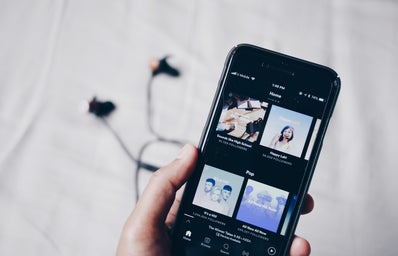In the music world, the Spotify vs. Apple Music rivalry is very real among streaming service users. It seems like you’re either a die-hard Apple Music user or a die-hard Spotify user. They’re both high-quality streaming services, but the social divide between them is bitter and intense. As a former Apple Music user, I’m extremely familiar with the societal shame that comes with not having Spotify. I wasn’t strong enough to withstand the peer pressure, and I finally made the switch to Spotify about a month ago.
I’d been meaning to make the switch for a while. Not only did I dread hearing my friends gently taunt me every day for using Apple Music, but hearing them discuss their carefully–crafted playlists, unique Spotify features, and ability to stalk each other’s user activities and accounts got old pretty quickly. The Spotify vertical videos and “Spotify Wrapped” posts on everyone’s Instagram stories did give me FOMO. Whenever a new album was released, my feed was flooded with links to songs on Spotify, each with aesthetically pleasing animations playing in the background. When you see these videos hundreds of times, you start wondering what you’re missing and wanting to post them yourself.
Another reason for my decision was that I never loved Apple Music while I had it. To be honest, it was just easier to use because my entire family used it as well. We all have iPhones, we’re on a family plan, and straying from the app just seemed difficult and unnecessary. Plus, I did enjoy the Apple Music’s lyrics feature, which Spotify doesn’t have. To me, lyrics are the most important aspect of a song, and having them on the screen really helped when learning new songs.
However, what’s cool about Spotify is that it has multiple plans to choose from. The student plan is only $4.99 a month, which is also the price of Apple Music’s student plan—but Spotify’s also comes with free access to Hulu, something I couldn’t resist. I signed up for the student plan last month and have been using it ever since. They also offer individual, duo, and family plans, while Apple Music only has individual, student, and family.
Over the last month, I’ve found many reasons to prefer Spotify. For one, the overall aesthetic of the app is more appealing. When you open it, you see a home page filled with your recent listens, specifically curated playlists, and a large selection of other playlists and categories that the app’s algorithm presents based on what you’re listening to. While Apple Music does offer some specially curated playlists, I found Spotify to have a wider variety of playlists tailored to specific emotions, ideas, etc. available right from the home page; for instance, they have playlists curated for each zodiac sign. Small features like that prove Spotify has personality and a unique passion for all aspects of music—something that Apple Music severely lacks.
Another huge perk of Spotify is that you can make creative playlists. It’s designed as a social app where you can view your friends’ profiles, playlists, and music choices. While Apple Music does have similar capabilities, Spotify has brought its social aspect to the forefront of its brand. No one uses Apple Music to look at others’ profiles, but on Spotify, that feature is what users embrace the most. As a user, you pay for the character ingrained in these unique features.
When you open your profile, you can create personalized playlists with your own cover art and descriptions, which lets you make your profile as creative as your Instagram feed. There’s something fun about personalizing your music the same way you would with a photo album. The Apple Music community doesn’t interact with the app’s features in the same way; when you open the Apple Music app, you’re simply brought to your library. When you do shift over to other tabs, you’ll see playlists or “Radios” under the Listen Now section that are presented based on your choices—however, they’re less specific and more genre–based. The Browse page is filled with promotional images and information for new music and, usually, the top 100 songs. Overall, Apple Music places emphasis on promotion in an obvious manner. Instead of clear features made for searching through friends’ profiles and finding new music, the app pushes a marketing, money–motivated agenda and feel.
Collaboration is also a neat bonus that Spotify offers and Apple Music doesn’t. You can collaborate with friends through a feature that allows multiple users to access and add to playlists, and there’s a feed that lets you see what your friends are listening to. This makes it much easier to discover new music from people with whom you share interests. By embracing collaboration, Spotify helps create a music community, which is something I’m really fond of. Ultimately, it feels more like a social media platform.
Since I’ve made the switch, I’ve had a lot of fun organizing my account the way I want. I get to stalk my friends’ profiles, see how they creatively organize their music into oddly specific playlists, and make playlists that fit my moods and help express my personality in a new way. I didn’t get that feeling from Apple Music.
For those of you who consider music to be an essential part of who you are, I highly recommend Spotify. It doubles as both a streaming service and a medium of self–expression through its highly customizable features and precise algorithm. Spotify ultimately just does a better job of highlighting all that’s good about music beyond just listening to it.
Am I still a little self–conscious about my listening activity? Of course (I admit I play a little too much Taylor Swift!) But, at the end of the day it’s a tradeoff I’m willing to take, because now I can embrace the musical side of myself with the people I’m closest to—plus the Hulu access!


